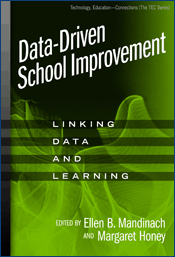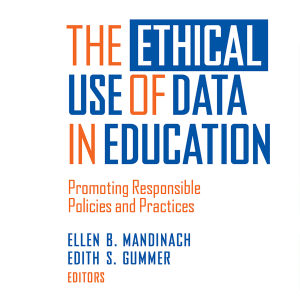Using Data in Efforts to Transform Teaching and Learning
Posted on

Data-driven decision making is one of the strategies most widely endorsed by policymakers and educational leaders as an effective way to improve instruction.
“Yet, when we show up to do workshops on data-driven decision making and I ask teachers how many of them have had a course on using data, I don’t see many raised hands,” says Ellen Mandinach, a senior research scientist at WestEd. “Schools of education, which never send their students into the classroom without a methods course, too often don’t ensure that their graduates have similar preparation in understanding and using data.”
Mandinach believes strongly in the potential of data-driven decision making (DDDM), which research is beginning to show has the power to transform educators’ practice and improve student achievement. As Director of WestEd’s Data for Decisions Initiative, Mandinach and her colleagues work with a variety of stakeholders to advance the use of data to improve teaching and learning. She is encouraged that policymakers at the highest levels, starting with U.S. Secretary of Education Arnie Duncan, see the importance of DDDM.
“They talk about the importance of arming educators at all levels with data,” says Mandinach, “and that to be more effective, teachers should tap into a range of information about their students, beyond just student assessments.”
Turning information into action
Educators who apply DDDM to their practice can reap significant results. Consider, for example, a group of teachers in one rural school district trying to uncover the reason behind poor behavior and academic performance in a particular group of students. “They had looked at every test score and performance measure imaginable but still couldn’t figure out why the kids were having so much difficulty,” says Mandinach. It was only after looking more deeply at all the data available to them, and specifically at transportation data, that they discovered that the struggling students were in fact those who spent the most time on the school bus. “They then were able to take that raw data — time on the bus — to create learning opportunities.”
In this case, bus schedules were modified to shorten students’ commutes, and Wi-Fi was installed on buses to make travel time more productive for the students. Mandinach calls this data literacy in action — the ability to understand and use multiple forms of data (e.g., data on attendance, student demographics, behavioral referrals, school surveys, classroom artifacts, and observations, as well as student performance data) to inform targeted solutions.
Mandinach contends that teachers need support to become data literate so they have information to inform their decisions, change their practice, and boost student achievement.
“States and districts are getting pretty good at collecting data,” says Mandinach. “But until you learn ways to take the raw data — whether qualitative or quantitative — and put them into some kind of education context, you don’t really provide much useful information. It’s that information that helps you determine the best instructional steps to take in the classroom.”
Mandinach remembers working with a high school math teacher in Arizona who had a student struggling to complete his homework assignments and who often fell asleep in class. The teacher learned that the student’s father was incarcerated and that he had two after-school jobs to help support his mother and four siblings. Armed with a clearer understanding of the student’s multiple, competing responsibilities (likely the case for many other students as well), the teacher made changes to his lesson plans — including adding more small-group activities and structured classroom discussions — to keep all his students more alert and engaged during class. He also found more classroom-based ways in which the struggling student and others could learn and succeed in the course, knowing that completing homework after school would continue to be a challenge.
Need for data literacy in teacher education programs
Mandinach led a WestEd study designed to examine the extent to which schools of education are teaching their students how to engage in data literacy. The study found that although most schools reported that they included data literacy in their curriculum, a closer examination of the syllabi revealed that the focus on data literacy was almost always cursory and usually concentrated solely on assessment data — the results of standardized tests or other assessment measures of student progress. While assessment data is critical to helping teachers understand their students’ academic performance, Mandinach says that it’s only one piece of a much larger body of knowledge that educators can, and should, tap into.
“True data literacy,” says Mandinach, “is the ability to connect a deep understanding of multiple forms of data — anything from how many students ride the school bus to students’ scores on attitudinal scales — with performance standards; curricular, content, and pedagogical knowledge; disciplinary practices; and an understanding of how children learn.”
According to the study’s findings, a greater emphasis on data literacy at schools of education could result from external pressures: new credentialing or licensure regulations, as well as demands from local school districts that new teachers possess such skills. To be sure, many school districts try to provide their teachers with DDDM skills through professional development opportunities. But the process is costly, time-consuming, and often ineffective. “There are a few really good providers out there, but even if a district finds one, the information can’t be delivered in a one-shot session. It has to be ongoing,” says Mandinach.
She also believes that because understanding data can affect virtually all instructional and classroom management decisions a teacher makes, “training on data literacy has to be introduced as early as possible in a teacher’s education — ideally at the teacher preparation stage — so it becomes an embedded skill set.”
Schools of education are beginning to realize that school districts increasingly want teachers skilled in DDDM, says Mandinach. Furthermore, she notes that the tests teacher candidates need to pass for licensing and certification, such as the PRAXIS, are developing data literacy components. Given such powerful incentives, some schools of education are starting to rethink — and beef up — their data-related coursework.
University of Delaware among schools of education leading the way
That’s the case at the University of Delaware, where educators are working to better align the School of Education’s teacher preparation program with the edTPA teacher licensing test. According to Elizabeth Farley-Ripple, an assistant professor of education at the university, the edTPA seeks to evaluate, among other things, how well teacher candidates can use data about their students to differentiate education or assess whether or not students have met instructional objectives.
“To prepare our students for the edTPA and to meet new state regulations that make data literacy part of the agenda, we began to look for ways to teach them how to better use data related to the academic, behavioral, and social-emotional components of teaching,” says Farley-Ripple.
Such external incentives, however, tell only part of the story. Faculty members meet regularly to engage in an internal improvement process. “As we discuss how well our courses are meeting our objectives, we increasingly find ourselves talking about the importance of data literacy for making our teacher candidates more pedagogically effective and well-rounded,” she says. “Which pushes us to consider which of our courses are touching on data literacy and how.”
Currently, the School of Education at Delaware does not offer a stand-alone course in data literacy. Instead, faculty members are addressing the subject themselves within the context of the subjects they teach. For example, in a math methods course, teachers typically learn how to identify errors in students’ mathematical reasoning. Ideally, says Farley-Ripple, they would simultaneously learn how to use data related to such errors to come up with targeted lesson plans to address students’ misconceptions.
Another example: Students taking a course in classroom management might learn not only how to record data on classroom behavior in the form of running records, but also how to turn that data into practical information to inform classroom strategies. For instance, a student in Delaware’s teacher leadership program took running notes on her third graders who were frequently having a hard time staying seated and paying attention. From analyzing this classroom behavior data, she was able to identify times of day when her students were the most restless so she could intervene accordingly; she also researched kinesthetic learning and began introducing movement into her classroom. Notes Farley-Ripple, “Teaching data literacy in a classroom context helps ensure that it becomes part of what teachers do, which means they are more likely to use it day to day.”
Lessons learned, next steps
Mandinach is encouraged by what is happening at teacher preparation programs like Delaware’s, and by “small pockets” of data-literate educators around the country. Supported by strong school and district leaders, and equipped with user-friendly data-related technology, they are finding ways, she says, to effectively use a range of educational data far wider than standardized test scores to transform their teaching.
However, Mandinach remains frustrated that so many schools of education offer very limited data-literacy training and support for their teacher candidates, though she acknowledges there are challenges, such as tight budgets and personnel constraints.
“We need to find a route around the impediments,” says Mandinach. “If you train teachers to use data in meaningful ways, it changes what they do in their classrooms and improves student performance. That’s a goal well worth pursuing.”


